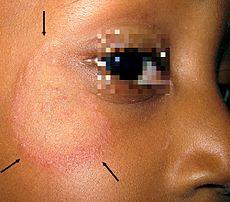Tinea Faciei (Fungal Skin Infection of the Face)
Skin fungi are tiny microorganisms that infect the outer surface of human skin. There are two main types of skin fungi – dermatophytes and yeasts. Most fungal infections of the skin are due to dermatophytes and are referred to as tinea. It is termed according to the location on the body where the fungal infection of the skin occurs. The more common types of skin fungal infections are the jock itch (tinea cruris) and athlete’s foot (tinea pedis). Other locations that may also be affected include the scalp (tinea capitis), face (tinea faciei), mustache and bearded area (tinea barbae), body (tinea corporis) and a type of yeast infection that almost only targets the neck, back, shoulders and chest (tinea versicolor). All of these skin fungal infections are caused by dermatophytes, except for tinea versicolor which is an yeast infection and incorrectly term as tinea.
What is tinea faciei?
Tinea faciei is a fungal infection of the skin on the face. It is a dermatophyte infection, hence the term tinea. Generally tinea faciei does not include the bearded area of the face as this is considered separately under tinea barbae. However, in cases where a fungal infection affect both the bearded area of the face as well as the other parts of the skin on the face, it may be generally termed as tinea faciei. Although a fungal infection of the skin on the face shouln be included with tinea corporis, it is often discussed separately because of its variation in appearance and the fact that is is commonly misdiagnosed as tinea versicolor (yeast skin infection) or other skin diseases.
Tinea faciei is uncommon and more likely to occur when it is spread from an animal to human, particularly from pets. It may occur simultaneously with other types of fungal infections on the body including tinea capitis (scalp) and tinea corporis (body). Tinea versicolor caused by the Pityriasis yeast is not frequently seen on the face and when it does occur, particularly in children, it has a different presentation from tinea faciei. The causative fungi are also different – tinea versicolor caused by an yeast and tinea faciei by a dermatophyte.
Causes of tinea faciei
Dermatophytes are keratonophilic fungi meaning that it contains enzymes known as keratinases which can break down the skin protein. It is therefore able to invade the outermost layer of human skin – stratum corneum of the epidermis – and does not usually extend into the follicle (fungal folliculitis). These fungi are isolated to the superficial layers of the skin. Tinea faciei may be due to fungi that have a predilection for humans (anthropophilic) or animals (zoophilic).
Anthropophilic fungi that cause tinea faciei can be transmitted from person to person and includes the species :
- Trichophyton rubrum
- Trichophyton tonsurans
- Tricophyton mentagrophytes
Zoophilic fungi that causes tinea faciei is transmitted from animal to person and includes the species :
- Microsporum canis
- Tinea verrocosum
The more common reservoirs of these zoophilic fungi which leads to tinea faciei are pets such as cats and dogs and livestock like cattle. These fungi tend to cause a more severe inflammatory reaction on the skin than anthropophilic fungi.
Skin fungi are more likely to cause an infection when it comes into contact with unhealthy skin – varying from a break in the skin to very dry skin. It is also more common in a person who has some underlying skin disease. There is evidence to suggest that skin fungi are also linked to a genetic susceptibility. Close contact with an infected person or an animal harboring these fungi, increases the risk of contracting a fungal infection of the skin.
Symptoms of Tinea Faciei
What does tinea faciei look like?
The rash in tinea faciei is largely the same as other dermatophyte infections which are often termed as a ringworm. A round to oval rash which is red, with dry scaling skin in the center and a raised border at the periphery. The border may also contain vesicles (tiny blisters) and crusts. The skin beyond the border may appear slight inflamed as if the rash is extending outwards. This differs from the whiter patches in tinea versicolor which is sometimes mistaken for hypopigmentation and related skin diseases like vitiligo.
Where does tinea faciei occur?
Tinea faciei occurs on the face but there are certain areas that are more commonly affected. The first of these is the cheeks where a single large or multiple smaller patches are seen. The other areas that are also commonly affected are the forehead, around the eyes, nose and chin. It almost never affects the entire face as a whole although there may be a few lesions in different parts of the face at the same time. Since tinea capitis (scalp fungus) may occur simultaneously, there may also be patches on the hairline and head (scalp).
Pictures of tinea faciei
| Picture of tinea faciei (face skin fungus) showing the rash around the eye extending to the cheek. Source : Wikimedia Commons.Other pictures of tinea faciei at Dermnet NZ. |
Treatment of Tinea Faciei
Tinea faciei can be effectively treated with topical antifungal applications.
- Ciclopirox
- Terbinafine
- Topical azoles like miconazole and itraconazole
Oral antifungals are usually not needed for treating tinea faciei. However, if the infection involves the follicles (fungal folliculitis) then oral therapy is necessary. Fungal folliculitis may occur with the unsupervised use of topical corticosteroids in an attempt to clear the skin rash. Therefore it is essential to seek medical attention for the rash to be properly diagnosed before attempting to use topical applications.






